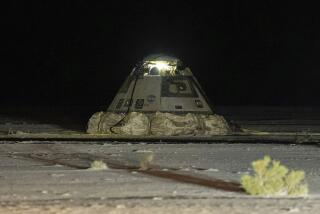Ground the Space Shuttle
- Share via
The space shuttle should never fly again.
As Times staff writer Robert Lee Hotz showed in a series explaining why Columbia exploded during reentry this year, killing seven astronauts, the $1.8-billion spacecraft was a miracle of ingenuity constructed from “the raw material of the American character.... It was America rising.” But as Hotz went on to point out, it was also “by design unsafe ... a white butterfly bolted to a bullet.”
Seventeen years ago, an eccentric Caltech-physicist-turned-bongo-drum-player named Richard Feynman dropped a rubber O-ring seal into a glass of ice water and discovered what an army of NASA experts had not: The cold-induced brittleness of the seal had led to the explosion of the space shuttle Challenger just after launch in 1986.
Back then, the space agency listened respectfully to Feynman. But in a reflection of how rigid, defensive and arrogant NASA has become, it brushed off scientists who conducted similarly ingenious experiments on their own to figure out the Columbia disaster.
One of them is Douglas Osheroff. Standing in his kitchen, the 1996 Nobel Prize winner for physics glued up pieces of fuel tank insulating foam and chilled them, in the end proving that NASA’s ideas about how the foam behaved were wrong. NASA officials rejected the ideas of Osheroff and other enterprising sleuths who believed, rightly, that detached foam had caused the accident, calling them “foamologists.”
The shuttle’s ascent and survival despite its design problems -- not to mention the inherent risk of human spaceflight -- are a testament to American resourcefulness. But NASA continues to be governed by an autocratic culture that stifles ingenuity. That’s not only the strong feeling of engineers at NASA’s subcontractors, it’s also the conclusion of NASA’s inspector general, Robert W. Cobb, who recently cautioned NASA Administrator Sean O’Keefe that agency hierarchies still discouraged independent engineering and safety.
Even if Lockheed Martin, which this month hired about 125 employees to redesign the shuttle’s foam-insulated external fuel tank, succeeds at the task, numerous other shuttle components have far outlived their intended design life.
Robot probes such as NASA’s Spirit and Opportunity, landers scheduled to arrive on Mars next month, can accomplish much more science more cheaply than human space missions. As for servicing the international space station, there is no shame in leaving it to the Russian Soyuz for as long as the project continues.
It’s too glib to blame NASA alone for the shuttle disasters. Congress relentlessly demanded cost cuts, and the public expected too many things of NASA -- that it provide inspiration, science and commerce faster, better and cheaper each year. In the end, a creaky, fearful bureaucracy bowed to its political masters and turned a blind eye to disaster in the making.
The space shuttle romance is over.






